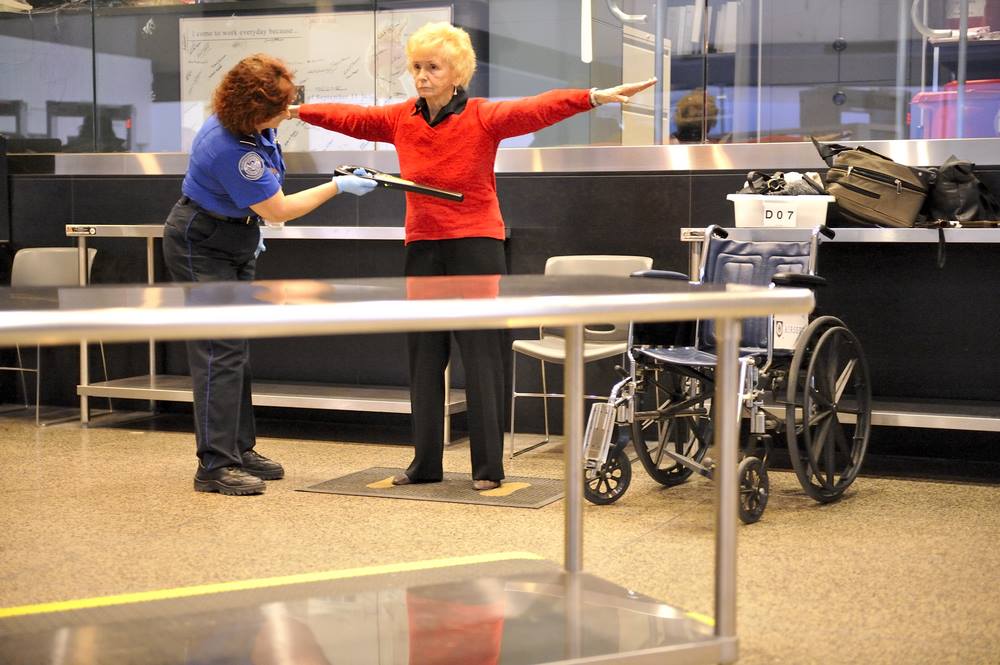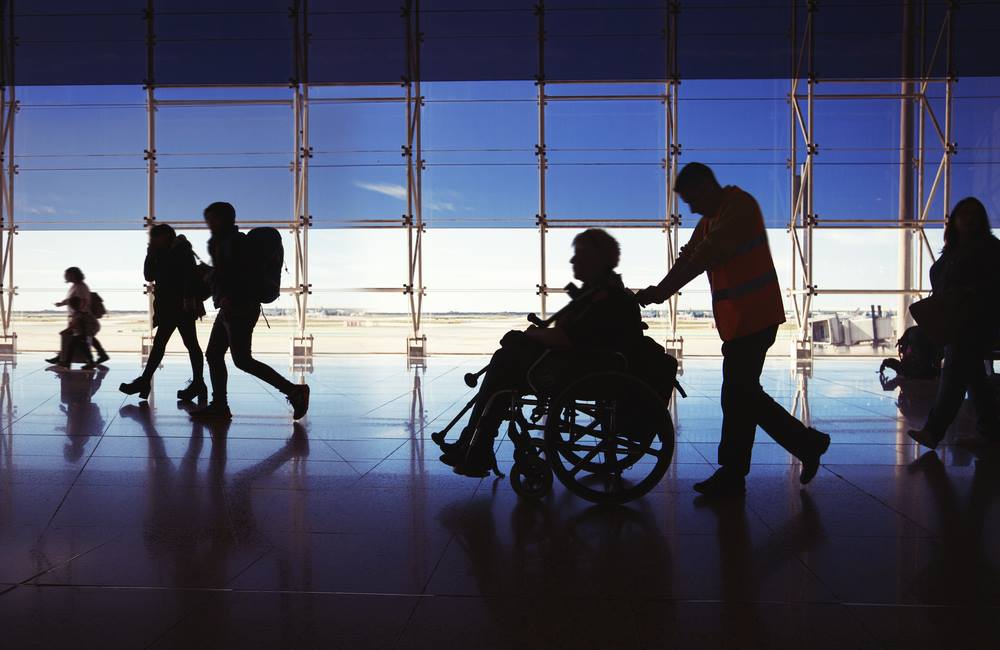
by Flying Angels Editorial Team | Feb 27, 2018 | News & Resources
For those traveling with disabilities or illness, important TSA travel tips will help everyone get prepared for their trip before leaving for the airport.
TSA Travel Tips
The first thing to know is that even if you are ill or disabled, that does not exempt you from having to go through security at an airport. All travelers are screened at airports, but the experience is different for those using non-emergency medical transport.
The following are some of the situations that likely will arise. The Transportation and Safety Administration has a complete rundown of various common issues on their website.
TSA Disability Notification Card
A good first step is to fill out a TSA Disability Notification Card that can be given to officers at the security gate. The card offers a quick overview that, coupled with other medical documentation, helps agents understand quickly your disability or condition.
Flight Nurse
Having a flight nurse, such as those who work with Flying Angels, gives you a partner in navigating the process. They can speak to officers about any concerns you have on security procedures, including alternative ways to handle the screening process.
Screening Process
Passengers with disabilities or illnesses can be checked through security in private rooms. Most, however, are not. Most security checks do not require those flying via medical transport to remove their shoes. However, the shoes will be checked both visually and physically. They may also be subject to explosives trace detection testing.
Other screening processes will include:
- Screening through advanced imaging technology if you can stand with your arms above your head for five to seven seconds without support or going through the walk-through metal detector if you can walk without support.
- All mobility aids such as walkers, crutches and canes – as well as medical devices – must undergo X-ray screening.
- Wheelchairs and scooters will also get screened by TSA officers, including seat cushions, non-removable pouches and fanny packs. Items will be tested for traces of explosives. Removable items will undergo X-ray screening.
Pat-down
If you cannot stand or walk through the detector, then a TSA agent will perform a pat-down while you are seated. For those who can stand for brief periods of time, you can stand near the wheelchair for a pat-down. If you go through the detector or the advanced imaging machine and an alarm is sounded, you also will undergo a pat-down.
TSA Pre-Check
One way to ease the process is to get approved for TSA Precheck, which means you will not be required to remove laptops, 3-1-1 liquids, belts or light jackets while going through security screening. You will, however, get screened via technology and possibly a pat-down. Other security measures may include swabbing your hands, any mobility aids you are using and medical equipment to search for explosive trace material.
Domestic vs. International
Generally speaking, domestic airlines are bit less demanding for those flying using non-emergency medical transport. Many also offer special assistants that you can call ahead of time and let them know your flight schedule.
American Airlines, for example, offers special assistance coordinators and a disability team that will work with you on wheelchair assistance, getting in and out of the plane, traveling with special medical equipment such as a portable oxygen concentrator, and arranging adjacent seating for you and your flight nurse.
International destinations often require more thorough medical checks, and international carriers typically have more stringent rules about getting clearance to fly with disabilities or illness. They may also require paperwork on medications and devices. This page from Air New Zealand offers a good idea of the types of rules you might encounter.
Flying with a disability or medical condition requires knowing these important TSA travel tips, pre-planning and preparation. With the right partner such as a flight coordinator and flight nurse, the experience can go much smoother.

by Flying Angels Editorial Team | Feb 15, 2018 | News & Resources
The nursing profession offers excellent job opportunities for those committed to a career focused on helping others. Becoming a flight nurse is among those options. It’s one that is in more demand than ever.
What Exactly Does A Flight Nurse Do?
Flight nurses are often associated with emergency transportation, keeping patients stable while they are flown from the scene of an accident or disaster to the trauma unit of a local hospital.
However, flight nurses also work for companies such as Flying Angels, giving patients the medical support, they need while getting non-emergency medical transport.
It’s a challenging and rewarding job in the nursing profession. Becoming one requires dedication and commitment to the nursing profession and a nurse’s goal of providing quality care for others.
Education Needed For A Flight Nurse
The recommendation for a flight nurse is a Bachelor of Science in Nursing degree. Four-year degree programs in nursing typically include coursework in physical and social sciences, critical thinking, communication and leadership. Bachelor’s degree programs in nursing also offer clinical experience.
Those that wish to take on leadership positions in the medical field may also earn a Master of Science degree in nursing. All nurses in every state – as well as the District of Columbia and U.S. territories – must also earn a license to practice as a nurse.
All this prepares you to become a registered nurse. Becoming a flight nurse takes further experience.
Experience
NEMT companies typically only consider applicants for flight nurse jobs from those with at least three years of experience as a nurse in an intensive care unit (ICU) or emergency room. Some have an even higher standards.
For example, Flying Angels usually looks for nurses with about five years of experience, according to Bob Bacheler, managing director at Flying Angels.
He said the ICU experience sharpens critical thinking skills and gives nurses exposure to very ill patients. Time working in an emergency room gives nurses experience in dealing with a high volume of patients, trauma cases, making good assessments and improving triage and physical skills.
Bacheler said whatever unit a nurse has experience in “you would want it to have the highest possible acuity and exposure to different patients.”
Certifications And Further Education
Those who want to become flight nurses can demonstrate their commitment to the career by earning a Certified Flight Registered Nurse (CFRN) designation from the Board of Certification for Emergency Nursing (BCEN).
Employers also look with favor on those who have earned a Critical Care Registered Nurse (CCRN) certification offered through the American Association of Critical Care Nurses.
Other coursework also should be taken. Bacheler, who has both a CFRN and CCRN, also is one of the authors of the coursework for the Trauma Practitioner Advanced Trauma Course. Required courses include Basic Life Support (BLS) and Advanced Cardiovascular Life Support (ACLS). Pediatric Advanced Life Support (PALS) is also available for those who plan to work with children.
Bacheler also serves as a board member for the Air & Surface Transport Nurses Association, which also offers guidance on becoming a flight nurse.

by Flying Angels Editorial Team | Feb 2, 2018 | News & Resources
For those who wish to travel to Hawaii but need to fly with a nurse, achieving that goal just got a little easier with NEMT to Hawaii.
NEMT To Hawaii
Flying Angels recently expanded its service area to include Hawaii. The company has staff based in Hawaii and can handle all the details in getting those to the Pacific island state who require non-emergency medical transport.
For those in such a situation, Flying Angels will “take care of everything,” the company says on its website.
Traveling To Hawaii
People can require support when traveling to Hawaii for any number of reasons. In some cases, it can be people who live there who are trying to return home from a distant location. In others, people may have travel plans for Hawaii but are not able to make the trip without flying with trained medical personnel.
Also, those in Hawaii may need transportation services from one island to another.
Hiring non-emergency medical transport can help in all these cases. Flying Angels specializes in providing medical care for those who need it when traveling, as well as arranging all the details of a trip to make it as non-stressful and enjoyable as possible.
Flying Angels Services
Flying Angels, based in Philadelphia, has emerged as a leader in the growing non-emergency medical transportation (NEMT) field.
NEMT is a very different service than an air ambulance, which is what many think of when they think about medical transport. In the case of an air ambulance, people are flown to trauma centers or intensive care units by helicopter or plane.
They are most often seen taking people from the site of major accidents or during natural disasters.
NEMT also transports patients, but under different circumstances. A NEMT service such as Flying Angels transports people using domestic and international commercial airlines, as well as with ground transportation to and from the airport.
A flight nurse travels with the patient. They are trained medical professionals capable of handling emergency situations. They also carry any medications a patient might need. They are with the patient the entire trip
Typically, people hire Flying Angels because they need to travel to another location for needed medical treatment and cannot get there on their own. Or, they are traveling elsewhere and experience a medical situation. Once they recover, a service such as Flying Angels can get them home safely.
They also fly with those who have chronic conditions or diseases when they travel for vacation – which is a service that could come in handy now that they provide NEMT to Hawaii.
The company offers some case examples of what they do for those interested in the medical transport service.
For those who want to fly to Hawaii and feel they may need medical assistance, Flying Angels is now making that dream easier to turn into a reality.



